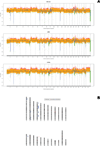Genomic deregulation during metastasis of renal cell carcinoma implements a myofibroblast-like program of gene expression
- PMID: 20952505
- PMCID: PMC3281492
- DOI: 10.1158/0008-5472.CAN-10-2279
Genomic deregulation during metastasis of renal cell carcinoma implements a myofibroblast-like program of gene expression
Abstract
Clear cell renal cell carcinoma (RCC) is the most common and invasive adult kidney cancer. The genetic and biological mechanisms that drive metastatic spread of RCC remain largely unknown. We have investigated the molecular signatures and underlying genomic aberrations associated with RCC metastasis, using an approach that combines a human xenograft model; expression profiling of RNA, DNA, and microRNA (miRNA); functional verification; and clinical validation. We show that increased metastatic activity is associated with acquisition of a myofibroblast-like signature in both tumor cell lines and in metastatic tumor biopsies. Our results also show that the mesenchymal trait did not provide an invasive advantage to the metastatic tumor cells. We further show that some of the constituents of the mesenchymal signature, including the expression of the well-characterized myofibroblastic marker S100A4, are functionally relevant. Epigenetic silencing and miRNA-induced expression changes accounted for the change in expression of a significant number of genes, including S100A4, in the myofibroblastic signature; however, DNA copy number variation did not affect the same set of genes. These findings provide evidence that widespread genetic and epigenetic alterations can lead directly to global deregulation of gene expression and contribute to the development or progression of RCC metastasis culminating in a highly malignant myofibroblast-like cell.
Conflict of interest statement
No potential conflicts of interest were disclosed.
Figures





Similar articles
-
DCLK1 is a broadly dysregulated target against epithelial-mesenchymal transition, focal adhesion, and stemness in clear cell renal carcinoma.Oncotarget. 2015 Feb 10;6(4):2193-205. doi: 10.18632/oncotarget.3059. Oncotarget. 2015. PMID: 25605241 Free PMC article.
-
Ghrelin promotes renal cell carcinoma metastasis via Snail activation and is associated with poor prognosis.J Pathol. 2015 Sep;237(1):50-61. doi: 10.1002/path.4552. Epub 2015 May 28. J Pathol. 2015. PMID: 25925728
-
Tumor suppressive microRNA‑138 contributes to cell migration and invasion through its targeting of vimentin in renal cell carcinoma.Int J Oncol. 2012 Sep;41(3):805-17. doi: 10.3892/ijo.2012.1543. Epub 2012 Jul 3. Int J Oncol. 2012. PMID: 22766839 Free PMC article.
-
Genetic and epigenetic alterations during renal carcinogenesis.Int J Clin Exp Pathol. 2010 Dec 13;4(1):58-73. Int J Clin Exp Pathol. 2010. PMID: 21228928 Free PMC article. Review.
-
The complex roles of microRNAs in the metastasis of renal cell carcinoma.J Nanosci Nanotechnol. 2013 May;13(5):3195-203. doi: 10.1166/jnn.2013.6712. J Nanosci Nanotechnol. 2013. PMID: 23858831 Review.
Cited by
-
Lineage plasticity in cancer: a shared pathway of therapeutic resistance.Nat Rev Clin Oncol. 2020 Jun;17(6):360-371. doi: 10.1038/s41571-020-0340-z. Epub 2020 Mar 9. Nat Rev Clin Oncol. 2020. PMID: 32152485 Free PMC article. Review.
-
MicroRNA-495 suppresses human renal cell carcinoma malignancy by targeting SATB1.Am J Transl Res. 2015 Oct 15;7(10):1992-9. eCollection 2015. Am J Transl Res. 2015. PMID: 26692942 Free PMC article.
-
A genome-wide comprehensively analyses of long noncoding RNA profiling and metastasis associated lncRNAs in renal cell carcinoma.Oncotarget. 2017 Sep 23;8(50):87773-87781. doi: 10.18632/oncotarget.21206. eCollection 2017 Oct 20. Oncotarget. 2017. PMID: 29152119 Free PMC article.
-
Sarcomatoid renal cell carcinoma: biology, natural history and management.Nat Rev Urol. 2020 Dec;17(12):659-678. doi: 10.1038/s41585-020-00382-9. Epub 2020 Oct 13. Nat Rev Urol. 2020. PMID: 33051619 Free PMC article. Review.
-
COL11A1/(pro)collagen 11A1 expression is a remarkable biomarker of human invasive carcinoma-associated stromal cells and carcinoma progression.Tumour Biol. 2015 Apr;36(4):2213-22. doi: 10.1007/s13277-015-3295-4. Epub 2015 Mar 12. Tumour Biol. 2015. PMID: 25761876 Review.
References
-
- van't Veer LJ, Bernards R. Enabling personalized cancer medicine through analysis of gene-expression patterns. Nature. 2008;452:564–570. - PubMed
-
- Chin K, DeVries S, Fridlyand J, et al. Genomic and transcriptional aberrations linked to breast cancer pathophysiologies. Cancer Cell. 2006;10:529–541. - PubMed
-
- Bestor TH. Unanswered questions about the role of promoter methylation in carcinogenesis. Ann N Y Acad Sci. 2003;983:22–27. - PubMed
Publication types
MeSH terms
Substances
Grants and funding
LinkOut - more resources
Full Text Sources
Other Literature Sources
Medical
Molecular Biology Databases
Research Materials

